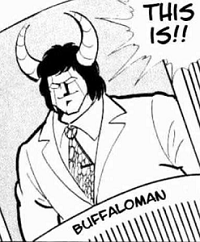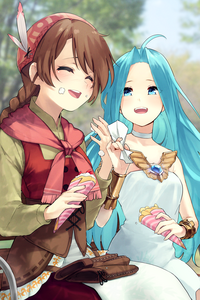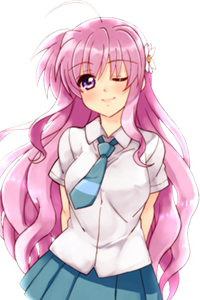For those who aren’t in the know, Devil May Cry is an action video game series produced by Capcom that’s been around since 2001. The star of the show is Dante, a demon hunter who shoots and slices devils and ghouls while doing it in the most badass way possible. As in, this is the same guy who killed dozens of demons in midair using an entire motorcycle. The gameplay is all about executing stylish and flashy combos for as long as possible, gaining “stylish” points the more complex you make them. As someone who’s beaten every game in the series (besides the second one, try to avoid that one as far as you can throw it), I can wholeheartedly recommend them if you’re itching for crazy, mindless action, as nothing quite comes close to them besides maybe the Bayonetta series, which I’ve been meaning to get to but have always been stopped by the second game’s damned Wii U exclusivity, but I digress.
I could go on for ages about each game, but sadly, they’re not what I’m talking about today. For the Summer season of 2007, studio Madhouse released Devil May Cry: The Animated Series, a 12-episode anime set between the first and second games. Instead of adapting a specific game, the series sets about on discovering Dante’s day to day demon hunting life when he’s not on a big adventure. Showing what the hero does between games is an idea with real potential for a video game adaptation, especially when games don’t see much anime series unless it’s a visual novel. Does it work? Not exactly.
Like I said, the anime’s main focus is shedding some light on the smaller jobs of Dante as he tries to stay afloat when faced with crippling debt, with each episode showing a different mission with new characters and new conflicts. It’s basically a “monster of the week” format, which is where the hero, according to local binge addiction source TV Tropes, “faces an unrelated monstrous threat once per weekly episode”. There’s some episodes that deviate from this formula, and coincidentally they’re the only ones I could describe as relatively decent, but for the most part, it’s very...boring, the best way to describe it. That’s not to say every Monster of the Week series is cut from the same mediocre cloth; Neon Genesis Evangelion focuses on a different Angel (the evil alien race the protagonists face) each episode, but it’s often interlaced with important character development or, even better, clues towards a bigger mystery that’s promised to come to a head towards the end. Sadly, that’s not the thing here. The lack of development is another can of worms for later in this piece, but none of the episodes hint at a greater threat or mystery. They don’t build off of past episodes either, as characters and plot points mostly don’t return (until the finale arc anyway), making them very standalone. The only sense that there’s any sort of continuity here is a character from the first episode that briefly shows up in every subsequent episode and a pretty inconsequential recurring villain, so there’s really nothing stopping you from watching these episodes out of order, which is probably a bad sign. With no sense of continuity or foreshadowing, it’s easy to not feel motivated when there’s no Big Bad Climax to be hyped for. Truth be told, I had to shift into Ludicrous Speed in the last few episodes, speeding by and only listening to the important bits of dialogue and action because of how depleted my tanks of care were. I guess this makes me look like a lazy critic, so rest assured, I’ll try not to do this with future reviews. Especially with shows that aren’t trash
But it’s fine as long as the standalone stories themselves are interesting, right? Not here, of course. With a video game adaptation that touches on untold stories of Dante’s career, there’s a lot of potential to be had. The video game series’s lore isn’t exactly the deepest stuff (it’s a stylish action game, after all), there could be some interesting premises that expand on the worldbuilding and provide more insight on certain plot points. What happened instead is that most of the episode plots have jack all to do with the lore of the video games, so often I felt like the only thing that linked this anime to the games was the fact that Dante was there, not to mention a couple of other characters that debuted in the games. There were only two episodes that built on existing lore; one had the two main female characters from the first and third games, Trish and Lady respectively, cross paths for the first time and explain why they’re so familiar with each other in the fourth game, and another episode introduced two former apprentices of the Legendary Dark Knight Sparda, Dante’s father….they were killed off in the same episode, but damn it, it was good progress. But besides those cases, most of the stories hardly felt like they came from the video games while failing to be engaging at the same time. I’m especially disappointed a certain perfect opportunity for an episode plot was entirely missed. Dante’s origin story is that he and his brother, Vergil, were the children of Sparda, a demon, and Eva, a human, and their house was set ablaze because of that unholy union, leaving Eva dead, Sparda more ambiguously dead, Vergil a runaway, and Dante on his own. It’s a vital part of Dante’s character arc, but it’s never shown in full detail until the fifth game, which came out this just this year and 12 years after the anime. But because we DMC fans can’t have good things, this event wasn’t even hinted at in the show. There wasn’t even an appearance from Vergil, my personal favorite character in the games and an all-around badass, though I guess it makes sense considering he was in a pretty bad state in that point in the timeline. Still sucks, though.
Now, there’s two versions of Dante in the game series. The one most people think of when he comes to mind is the cuhrayzee, partying, hard rocking deviant personality he has in the third, fourth, and fifth games, but in the first two games, although he still makes the occasional joke, he’s more subdued and emo and overall is sort of a blank slate. Unfortunately, it’s this latter version of Dante that’s shown in The Animated Series. In the games, Dante isn’t really known for having depth or character development for the most part, but this is more acceptable post-DMC2 where you just revel in Dante’s wild antics. DMC1, meanwhile, had a frankly dull story because Dante took everything seriously and said almost nothing for the whole game, and it’s almost the same here. Hell, he doesn’t even execute any of his trademark moves or stylish battle sequences from the game, as if the series were afraid to make itself look cool.
Fortunately, he still cracked plenty of jokes in every episode, so that he wasn’t completely moody and edgy. In the end, I suppose I don’t mind that they used this version of Dante compared to the more famous party rocker Dante, but it would have been more forgivable if they tried to explain why he was so depressed for the first half of the franchise timeline. But, like many other potential story ideas for this show, the writers flopped on the couch with their favorite bag of Doritos and said “Nah, I’ll do it later”. I already explained how Dante is mostly a static character in the games, but he still has the small moment of development once every game. Here, he’s the same character from the first scene of the anime to the last, with hardly any character growth or drastic changes. It’s a weird thought when a main character feels like the backdrop of his own show, but indeed, he barely has anything to do with the plot of each episode. Other notable episodic series, like Cowboy Bebop and Samurai Champloo, have stories that make the characters feel involved or tie into their past. You’ll find no such thing in DMC The Series; Dante is merely a vehicle for one-off characters’ stories, a solution to their devil-plagued problems who doesn’t learn any lessons. There’s even one episode where the Extras of the Week confuse Dante for another person, so the plot’s not related to him in the slightest! You’ll be hard-pressed to find any sort of investment in Dante.
There’s only five other characters that make enough appearances to constitute a main cast, but for the most part, they don’t really pick up the slack left by Dante. Lady from Devil May Cry 3 is a personal favorite of mine, and luckily she’s in half of the episodes, but the anime’s apparent disdain of anything over the top doesn’t give her much room to flap her wings, and Trish from the first DMC shows up sometimes, but….to be honest I never cared about her in the games so let’s move on. Patty Lowell is a young girl that becomes Dante’s roommate for the entirety of the series after being rescued in the first episode, but she might as well been left alone. She serves no other purpose than to be the annoying comic relief, doing nothing to help out Dante and constantly putting Dante deeper into debt. There’s Morrison, Dante’s agent who appears in a good number of episodes, but he doesn’t have any real personality and might as well just be a prop. And while there is a main villain of the series, his presence is so laughable it might as well not matter. For the majority of the run, he’s only a minor demon who doesn’t do anything more than mildly inconvenience Dante and friends, leading to his rise to godlike power in the final episode to have pretty much no buildup and no reason to care. Also, he has a stupid name. Not that important, but it’s worth pointing out.
Luckily, nothing’s lacking in the animation department. Madhouse is practically the best there is when it comes to good ol bloody violence, as shown with Black Lagoon, Hellsing Ultimate, and my previously reviewed Trigun, so putting this series in their hands was a very fitting choice. Although the action choreography isn’t as good as it could have been, as this was DMC1 Dante where things were relatively down to earth and he wasn’t nailing demons in the head with cue balls, it’s pretty fluidly put together and has nice shot composition on occasions. The music is...serviceable. It’s nothing fantastic, but it does the job just fine. The OP song is a banger of a track, even if the visuals that accompany it are rather dull. A good rule of thumb is that an OP needs to have both strong visuals and music for it to be something truly great. The Japanese voice acting was good, though it’s hard to pick up on the nuances of a language I don’t speak. The dub is something of a mixed bag, however. It uses Dante’s regular voice actor, who perfectly fits in the role like it’s a glass slipper, but the actors for all the extras and one-offs are average at best and amateurish at worst.
Lastly, I want to pick up a few idiotic but critical character fuck-ups that I can’t help but share. One episode features a genie demon that refuses someone’s (let’s call him Kerry) first three wishes, but upon saying “drop dead” to his brother after losing a game to him, the demon grants that unintentional wish and kills the brother. Kerry thinks it was his fault for a crime he didn’t really commit, and with nothing else to go off of, he’s arrested and taken to prison. But the police did have something to go off of: the demon killed his brother by spitting acid at him and melting him into nothing but a skeleton; a regular person couldn’t do this by any conventional means! There was even a witness who saw him disintegrate, so Kerry shouldn’t have been arrested in the first place! Another episode has a demon named King who kills gamblers by taking their souls if they lose a game against him. To get more prey, he invites Dante to a high-class poker game on a cruise ship. It would make sense if Dante was a proficient gambler, but he’s not shown gambling in either the games or anime. So we can assume King only invited him because he knew he was a devil hunter, so in other words, he was basically asking for his death! The dialogue in this anime is pretty true for a DMC adaptation, but the writing everywhere else….isn’t the best with logic, to say the least.
With an anime this mediocre, it’d make sense that Capcom would want to ignore it as much as possible in the games. Sure enough, when the fourth game came out the next year, it didn’t have even the slightest mention of the events of the show. Turns out it was canon all along when Patty and Morrison made small appearances in the fifth game (albeit Morrison inconspicuously had his race changed from white to black, but it still counts). The bottom line is: if you’ve played a good deal of the series and you like what you saw, then it wouldn’t hurt to check this out if you’re really curious, but if not, then you probably shouldn’t bother. There’s much better gritty action anime worth investing your time into, especially from the same studio. It’s not the worst thing in the world, but it’s more along the lines of aggressively average. Probably worse, as it’s better to be laughably bad, where you have fun riffing at it along the ride, than to be average, where there’s almost nothing to make fun of. In other words, this show didn’t hit the jackpot.
















![[Image: U7dyPAD.png]](https://i.imgur.com/U7dyPAD.png)







![[Image: 220px-Devil_May_Cry_vol_1.jpg]](https://upload.wikimedia.org/wikipedia/en/thumb/e/e4/Devil_May_Cry_vol_1.jpg/220px-Devil_May_Cry_vol_1.jpg)



![[Image: s2n7oi.png]](https://files.catbox.moe/s2n7oi.png)